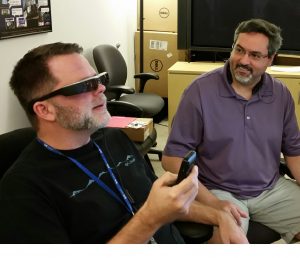“Our job at the lab is to find technology that’s new, cutting edge and cool – and to give it to someone else to be brilliant with.” – Matthew Horn, Manager, SAS Emerging Technologies UI Lab

If you’ve heard of Google Glasses or Occulus Rift, you’ve heard of augmented reality. But how does augmented reality differ from virtual reality? And how might you realistically use it in a business setting?
I spoke with Matthew Horn, Manager of the SAS Emerging Technology UI Lab to learn more about this technology and its usefulness for business. Keep reading to learn from what he told me.
What it is
Matthew Horn: Augmented reality puts data on top of what you normally see.
What it isn’t
Horn: Augmented reality is not just a head’s up display, and it’s not the same thing as virtual reality. Head’s up displays provide information on a dashboard or screen that may or may not be related to what you’re currently looking at. The speedometer on your dashboard is an example. Virtual reality, on the other hand, replaces everything you see. It immerses you in a computer generated world and completely replaces your vision. Augmented reality is a nice blend of the two. You view the world through glasses or goggles that react to what you’re already looking at by laying relevant information on top of what you’re seeing.
How it works
Horn: Augmented reality interacts with what is right in front of you. Imagine the entire world as a Web page, with information behind every object you can see. The information displayed can be powered by a barcode or object recognition or many other mechanisms. Generally, augmented reality glasses are programmed to recognize objects and display information about them, as opposed to the objects being programmed to send information to the glasses.
The possibilities
Horn: Imagine you are standing on a platform overlooking a manufacturing floor. As you look around the plant, you can see statistics such as downtime, defects and average production times for each machine. The technology can also tie in with GPS and know you’re at the mall or at an airport and bring up different information based on your location. If you’re a delivery driver, it could provide information for each customer based on your location.
The challenges
Horn: Studies into augmented reality have found that about 1 in 12 people have a very adverse reaction to it. I’ve found the same ratio in our lab. One person became so sick that he threw the glasses at me! It looked like somebody had punched him. When looking from object to object, your eyes move first and then your head. Trying to associate objects with what you’re looking at can cause equilibrium issues if the image moves too soon. It has taken awhile for the technology to accommodate for this, so that the information you’re viewing stays where it’s supposed to stay.
Yes or no, the bottom line
Horn: Everything is data. The hardest part is getting people to realize that. Whether you’re talking about how a workspace is laid out, how the productivity flows in the company or how customers come into your store, there’s a billion different ways to look at data and analytics. Augmented reality is one way to tap into information that is otherwise going untapped. This is a technology to watch, but one to wait on right now as the price points come down and the technology continues to improve.
Read more posts in this series, and get more insights about analytics technologies from the SAS Insights page.

3 Comments
Wow, amazing. Sounds like science fiction coming to today's world. Can't wait to see this in real world setting
i used augmented reality on my android in 2009 to see houses for sale as i was in an area. The Layar app really worked well, you can select what the layer should be from a list of data layers.
http://www.youtube.com/watch?v=b64_16K2e08
glasses would have made it even more useful.
Have you tried leap motion to manipulate screen objects with your hands and fingers? It is also cool.
I tried it on sas va, to drag columns into the pane, but that didnt work so well with the mouse interface i had to use.
I'm glad you explained that augmented reality is a blend of a heads-up display and virtual reality, since it reacts to what you're looking at and adds something relevant on top of what you're seeing. During our family dinner last night, the kids were talking about virtual reality and I heard the term augmented reality used as well. I wasn't sure what it was, so thanks for explaining it in a way I could understand. It sounds really interested and fun; I think I'll look for a local place to try it out!